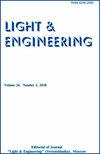光与气候:文化贵重物品保护的法规要求与实践
IF 0.3
4区 工程技术
Q4 ENGINEERING, ELECTRICAL & ELECTRONIC
引用次数: 0
摘要
本文介绍了与博物馆照明控制标准制定有关的一组数据。检讨的主要目的,是要证明在调整照明以改善博物馆展品的保存和调整照明以改善展品向参观者展示之间的平衡。自2018年以来,博物馆照明法规的开发活动日益频繁,因此有必要进行审查。作为这些活动的一部分,两个主要组织的专家——俄罗斯照明研究所(VNISI)的照明工程师和国家修复研究所的博物馆和修复社区——履行了一项合同,对博物馆照明领域的博物馆实践进行分析。在俄罗斯联邦照明工业科学技术委员会(STC“Svetotekhnika”)博物馆照明委员会的一次扩展会议上,对合同下的研究结果进行了审查和批准,博物馆界的代表参加了会议。这项工作的结果也在gosnir科学委员会的一次会议上进行了讨论。2020年,VNISI专家在履行合同后制定了博物馆LED照明的四项规定。本文简要介绍了这些文献对促进LED博物馆照明发展的潜力。这表明制定的标准对博物馆实际需求的适用性有限,以及开发商所犯的错误,如果这些标准在实践中使用,将给博物馆展品的保存带来风险。作者提出了进一步发展和完善博物馆照明监管框架的途径。在gosnir科学委员会会议上讨论并批准了这些方法和监管发展计划。本文章由计算机程序翻译,如有差异,请以英文原文为准。
Light and Climate: Regulatory Requirements and Practice of Cultural Valuables Preservation
The article presents the set of data related to development of museum illumination control standards. The main goal of the review is to demonstrate the balance between illumination adjustment as a means to improve preservation of museum exhibits and adjustment as a means to improve presentation of exhibits to visitors. Such review became necessary due to intensification of activities for development of museum illumination regulations since 2018. As part of these activities, the specialists of two leading organisations – light engineers of the Russian Lighting Research Institute named after S.I. Vavilov (VNISI) and the museum and restoration community of the State Research Institute for Restoration – fulfilled a contract for analysis of museum practice in the sphere of museum illumination. The results of the studies under the contract were reviewed and approved during an extended meeting of the museum illumination commission of the Scientific and Technical Council of the Lighting Industry in the Russian Federation (STC “Svetotekhnika”) with participation of representatives of the museum community. The results of this work were also discussed at a meeting of the scientific council of GosNIIR. In 2020, specialists of VNISI developed four regulations of LED illumination for museums after fulfilling the contract. The article presents a brief description of the potential of these documents for improvement of development of LED museum illumination. It demonstrates limited applicability of the developed standards to actual needs of museums and the mistakes made by the developers, which pose risks for preservation of museum exhibits if these standards are used in practice. The author proposes the ways of further development and improvement of the regulatory framework of museum illumination. These ways and the programme of regulation development were discussed and approved at the meeting of the scientific council of GosNIIR.
求助全文
通过发布文献求助,成功后即可免费获取论文全文。
去求助
来源期刊

Light & Engineering
ENGINEERING, ELECTRICAL & ELECTRONIC-OPTICS
CiteScore
1.00
自引率
50.00%
发文量
0
审稿时长
1 months
期刊介绍:
Our magazine
develops comprehensive communication within the lighting community, providing opportunities for discussion and free expression of opinions of specialists of different profiles;
contributes to the convergence of science and engineering practice, the search for opportunities for the application of research results in lighting and technological applications of light;
keeps the scientific community up to date with the latest advances in the theory of the light field, providing readers with operational professional information;
initiates international cooperation, promotes and distributes the results of Russian authors in the international professional community;
provides equal opportunities for authors from different regions of Russia and other countries.
The journal publishes articles in the following areas:
visual and non-visual effects of radiation on humans;
light field theory;
photometry and colorimetry;
sources of light;
ballasts;
light devices, their design and production technology;
lighting and irradiation installation;
light signaling;
methods of mathematical modeling of light devices and installations;
problems of energy saving in lighting, installation and operation of lighting installations;
modern production technologies of lighting products for lighting control systems;
innovative design solutions;
innovations in lighting and lighting design;
the study of the effect on plants and animals, problems of using light in medicine;
problems of disinfection of premises, water and smell elimination with the help of technology of UV radiation using;
problems of light in the ocean and space.
 求助内容:
求助内容: 应助结果提醒方式:
应助结果提醒方式:


